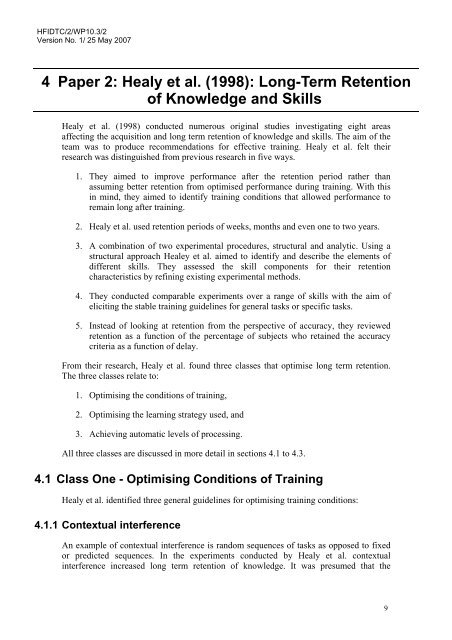Literature Review on Skill Fade - Human Factors Integration ...
Literature Review on Skill Fade - Human Factors Integration ...
Literature Review on Skill Fade - Human Factors Integration ...
You also want an ePaper? Increase the reach of your titles
YUMPU automatically turns print PDFs into web optimized ePapers that Google loves.
HFIDTC/2/WP10.3/2<br />
Versi<strong>on</strong> No. 1/ 25 May 2007<br />
4 Paper 2: Healy et al. (1998): L<strong>on</strong>g-Term Retenti<strong>on</strong><br />
of Knowledge and <strong>Skill</strong>s<br />
Healy et al. (1998) c<strong>on</strong>ducted numerous original studies investigating eight areas<br />
affecting the acquisiti<strong>on</strong> and l<strong>on</strong>g term retenti<strong>on</strong> of knowledge and skills. The aim of the<br />
team was to produce recommendati<strong>on</strong>s for effective training. Healy et al. felt their<br />
research was distinguished from previous research in five ways.<br />
1. They aimed to improve performance after the retenti<strong>on</strong> period rather than<br />
assuming better retenti<strong>on</strong> from optimised performance during training. With this<br />
in mind, they aimed to identify training c<strong>on</strong>diti<strong>on</strong>s that allowed performance to<br />
remain l<strong>on</strong>g after training.<br />
2. Healy et al. used retenti<strong>on</strong> periods of weeks, m<strong>on</strong>ths and even <strong>on</strong>e to two years.<br />
3. A combinati<strong>on</strong> of two experimental procedures, structural and analytic. Using a<br />
structural approach Healey et al. aimed to identify and describe the elements of<br />
different skills. They assessed the skill comp<strong>on</strong>ents for their retenti<strong>on</strong><br />
characteristics by refining existing experimental methods.<br />
4. They c<strong>on</strong>ducted comparable experiments over a range of skills with the aim of<br />
eliciting the stable training guidelines for general tasks or specific tasks.<br />
5. Instead of looking at retenti<strong>on</strong> from the perspective of accuracy, they reviewed<br />
retenti<strong>on</strong> as a functi<strong>on</strong> of the percentage of subjects who retained the accuracy<br />
criteria as a functi<strong>on</strong> of delay.<br />
From their research, Healy et al. found three classes that optimise l<strong>on</strong>g term retenti<strong>on</strong>.<br />
The three classes relate to:<br />
1. Optimising the c<strong>on</strong>diti<strong>on</strong>s of training,<br />
2. Optimising the learning strategy used, and<br />
3. Achieving automatic levels of processing.<br />
All three classes are discussed in more detail in secti<strong>on</strong>s 4.1 to 4.3.<br />
4.1 Class One - Optimising C<strong>on</strong>diti<strong>on</strong>s of Training<br />
Healy et al. identified three general guidelines for optimising training c<strong>on</strong>diti<strong>on</strong>s:<br />
4.1.1 C<strong>on</strong>textual interference<br />
An example of c<strong>on</strong>textual interference is random sequences of tasks as opposed to fixed<br />
or predicted sequences. In the experiments c<strong>on</strong>ducted by Healy et al. c<strong>on</strong>textual<br />
interference increased l<strong>on</strong>g term retenti<strong>on</strong> of knowledge. It was presumed that the<br />
9
















